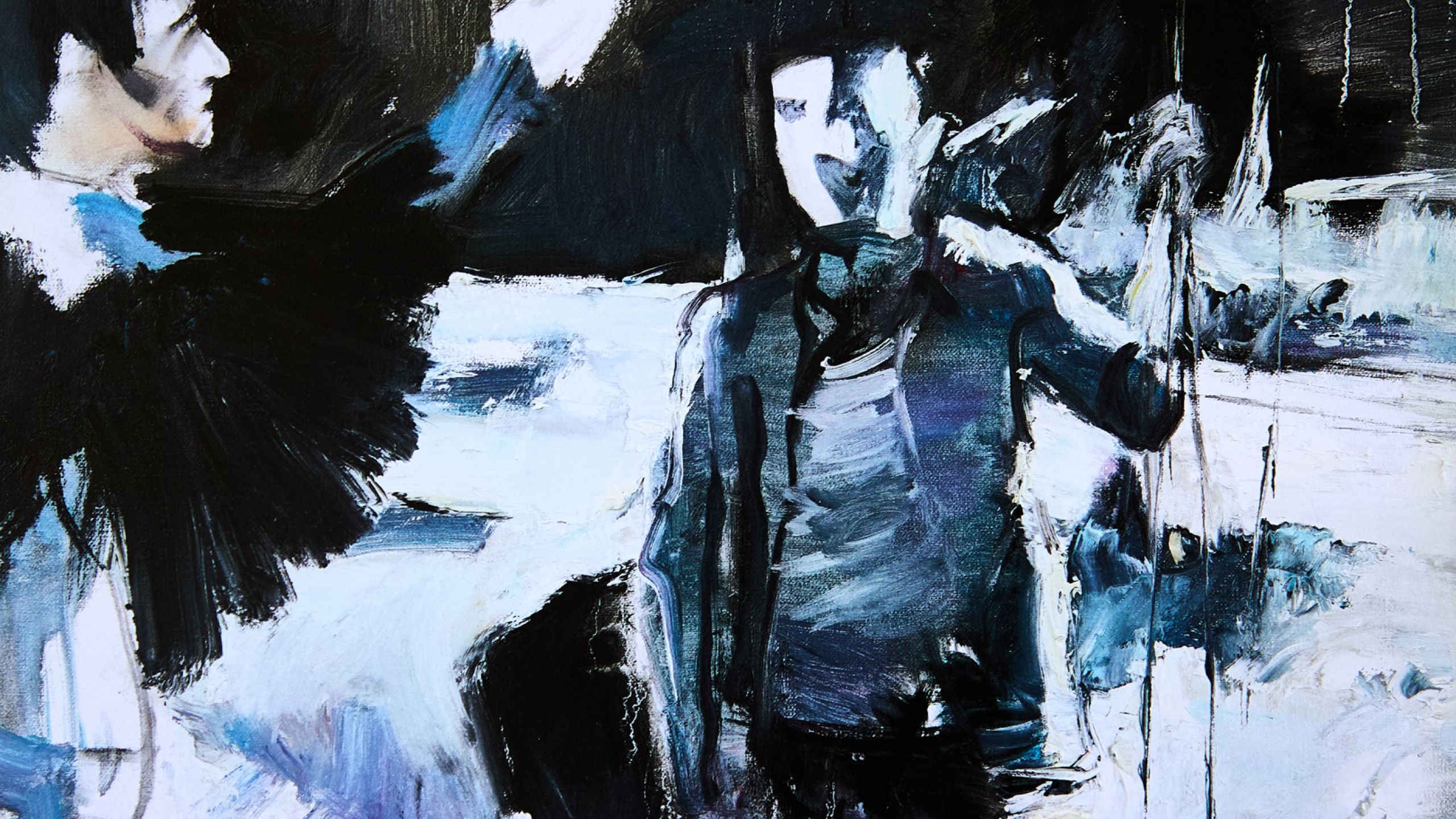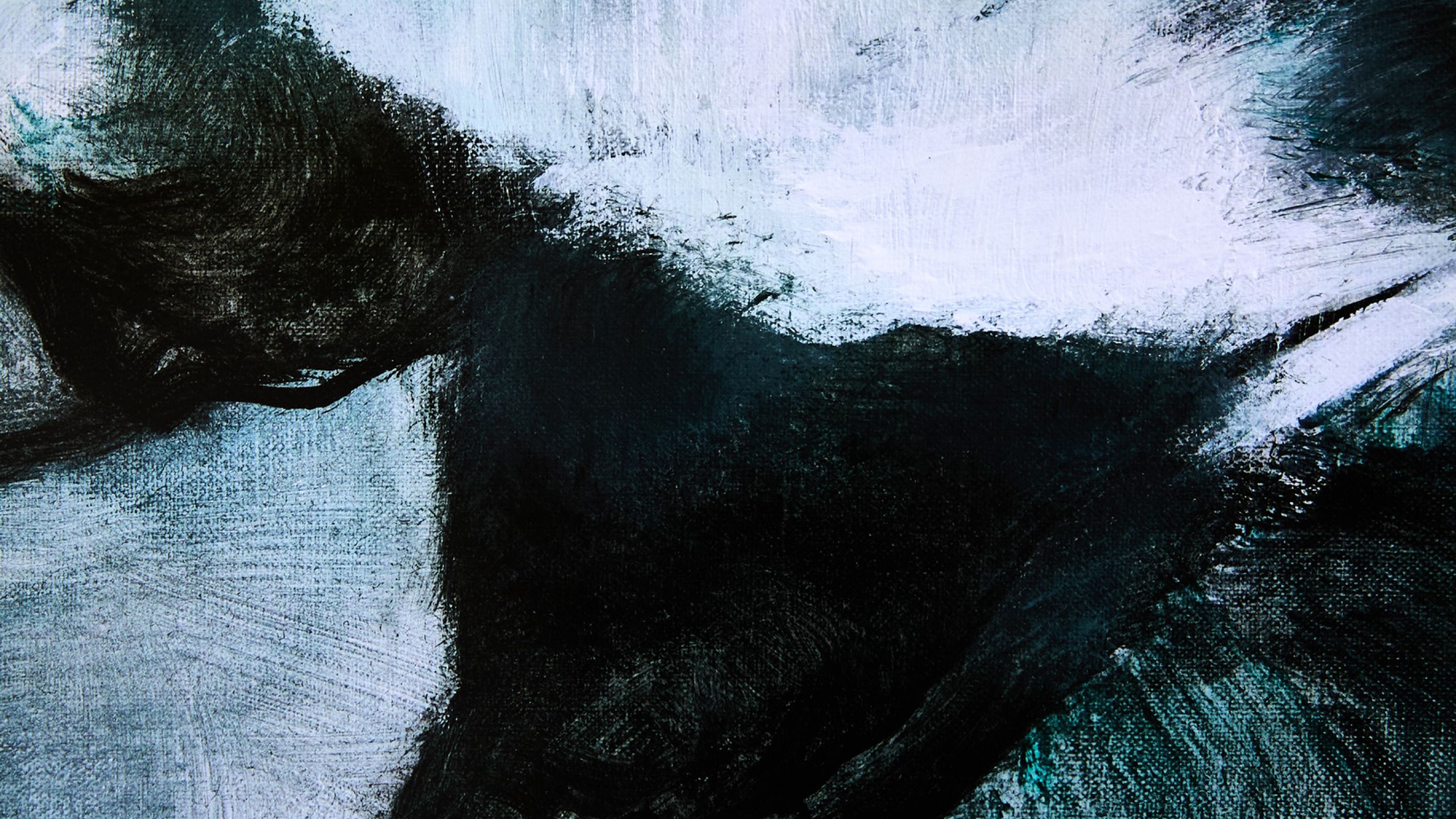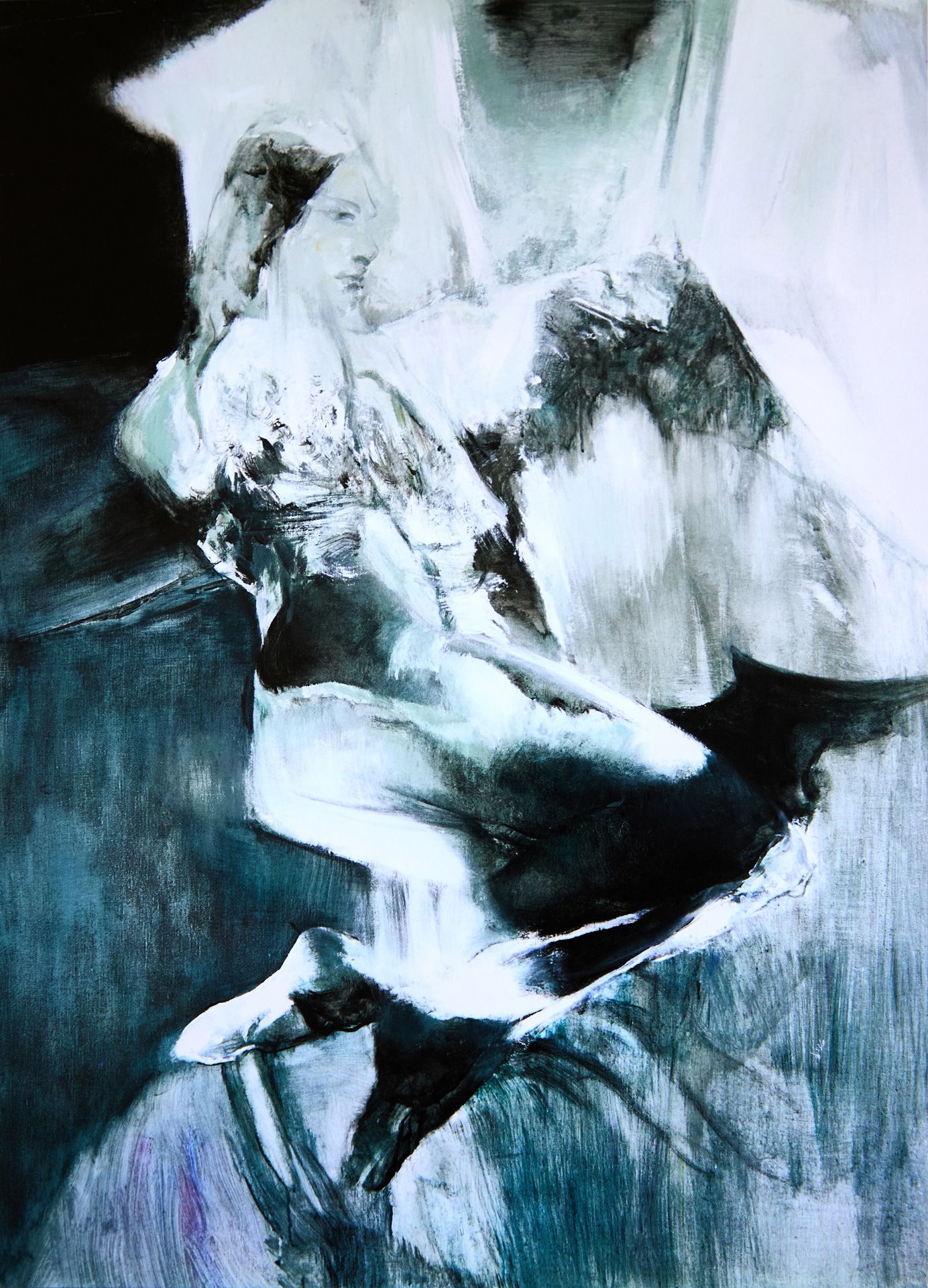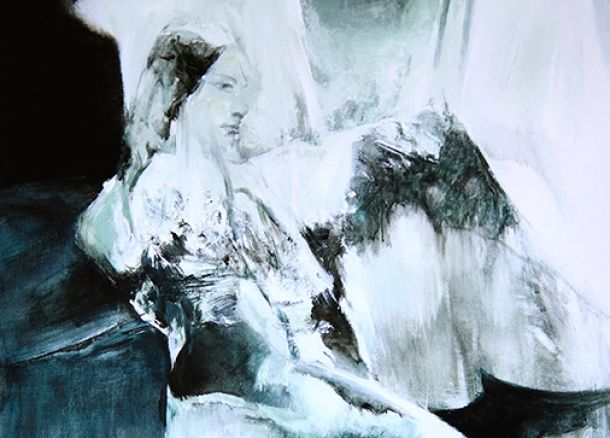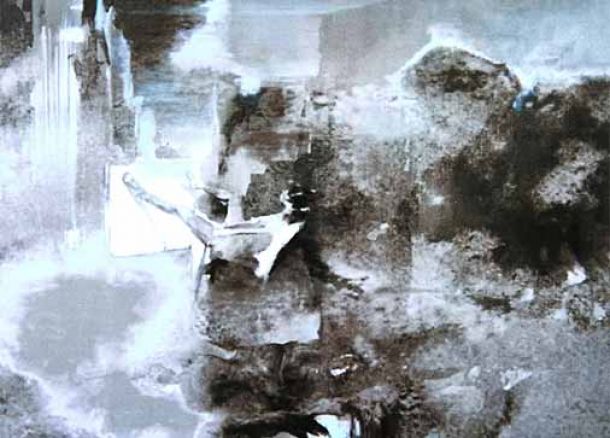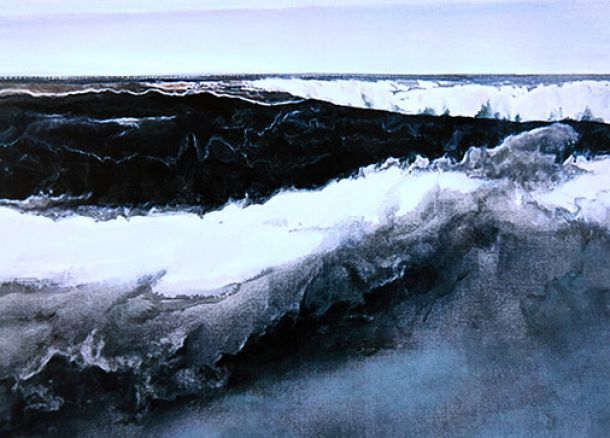Yu Runde is indeed a brilliant artist– at least he is a person of integrity who disdains to please the market with mundane works.
However, he is recognized by most people for his devotion to education over years and impresses them with elegant manners in various social occasions as a public figure. Seldom do they know that Yu is a man of great artistic accomplishments.
As an old acquaintance of Yu, I know him as a devoted teacher. Since I seldom see his paintings, I often forget him of being an artist as well. There were several times when we went out sketching together with some students and Yu played the violin and guitar during lunch time. His great passion for music gave us a lot pleasures, which also reminded me of his versatility.
What his artistic idealism is remains a haunting mystery to me.
On another occasion when we went out sketching near his studio at Shidu scenic spot in the outskirt of Beijing, I saw one of his landscape paintings by chance. It was about the scenery outside the window viewing from inside the studio. The subject matter of the picture was plain, yet it was uniquely framed and brightly colored and following none of the prevailing fashion temporarily.
I was startled by his artistic talent and since then I always felt regretful for him of not having enough time for painting due to the trifling working issues.
My concerns for him was later proved unnecessary. Yu never stopped painting at his leisure and simply kept the works to himself.
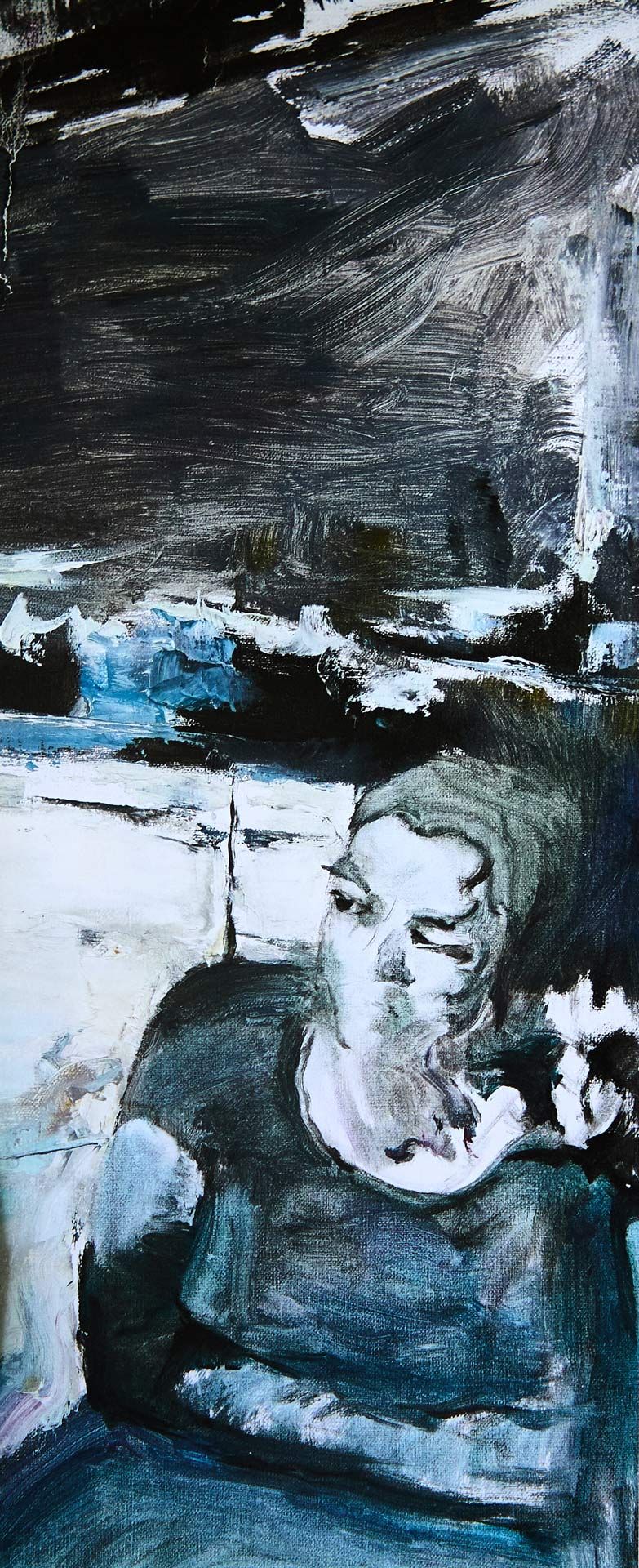
One of the most frequent phrases Yu quoted was “keeping a low profile”, which was the motto for both his cause of art and life. Rather than the artist, I would call him “the hermit dwelling in the earthly world”. Yu had no interests in fame or material profits that were pursued by many other painters; instead, he preferred secluding himself in the studio to get a relaxation as well as concentrate on painting. He had a keen observation to the aesthetic values of contemporary art. Yu once said, “I envy those who can totally devote themselves in painting since I often get engaged in many other issues; I’m not allowed to paint at any time, therefore I have to plot it in my mind and then draw it out when I get time. I treasure those momentary inspirations, those I do enjoy being busy”.
Yu continually recorded his inspirations down on paper or canvas, that’s how he managed to compose considerable artworks despite busy works.
Yu was aware that an artist was supposed to form his own style. He was like a hermit, drawing lessons from others quietly while never judging openly. He made continual attempts in artistic innovation through repeated experiments, introspection and self-negations, and his styles ranged widely from wash painting to oil painting and sketches. However, he was not in haste to draw certain conclusion and he was still on the way establishing his own fashion in accordance with his free and easy personality.
His bold attempts remained controversial and brought about disputes: some thought his wash paintings too westernized while others considered his oil painting containing as too Chinese-featured. Rather than disturbed by these criticisms, Yu continued his experiments on combining elements from different cultures. As a master of both wash painting and oil painting, he created a mixed sense of limpidness and complexity in his works. Having the conscience of a learned man in the present age and concerned with the spiritual world of Chinese people, Yu considered the cultural independence of China as his artistic pursuit, which was the wisest perspective in the current Chinese context.
Yu’s every piece of artwork was the result of repeated reflections and revisions. When he looked at the canvas, he looked deep into his heart. Yu once commented on himself, ” I tend to act after prudent consideration. I won’t start painting when I’m not in the mood. When I feel the mood for painting, I was like amid a dreamlike fantasy which would be externalized by the illusive atmosphere of my painting. To compose an original scene with only black and white color requires more than the superb craftsmanship; I need to be fully devoted to present my spiritual world on the one-meter-long canvas with unique and original perspectives, thus acquiring the unity of my inner self and the outside world.
Yu understood the importance of choosing proper subject matter. The subjects of Yu’s paintings basically fell into two categories: real people and transcendental beings. On the one hand, Yu gave a realistic portrait to people in contemporary context in his works such as The Impression of Peach Blossom and On the Edge of Weightlessness. On the other hand, he expressed transcendentalist idealism in his works, such as oneness of heaven of human beings, represented by The Blurred Radiance. Above were Yu’s representative paintings with his unique characteristics. It seemed unbelievable that such contrasting artistic styles should be from the same person. These two styles accorded with ancient Chinese scholar’s two major attitudes towards life–either playing an active part in social life or retiring from the earthly world. When he felt the need of venting his cynicism, he expressed his criticism through realistic approach. As he wrote in the notebook, “despite the main trend of material worship and amusing ourselves to death, there should always be a certain conscious voice to remind people of the chaotic social states, the mental paralysis of the majority, and cultural predicament we are faced with, however weak the voice might be”. When his disappointment, helplessness and loneliness was beyond solution, he would seclude himself from the realistic world and express his transcendental idealism in the paintings. “The magic of shades and lines is the representation of artist’s spirits and poetic grace, conveying their transcendental ideals and emotional feelings for the unspeakable sense of life, for which they hold the sublime aspiration of becoming a free will to reach the eternal and the infinite.”
These two categories were by no means contradictory with each other. The former one was call of the time, while the latter was the call of his own heart. Yet the ultimate pursuit of him wais transcendentalist idealism. I personally preferred the latter style of his works. Within this style of paintings, there were a sense of unity between heaven and human beings, a state that was between the dynamic and the static, the present and the absent, the real and the illusive. Human body were commonly considered as a symbol of life, an overwhelming, fathomless, incessant and eternal torrent of emotions. Yet Yu hid this symbol of life amid the diffuse mist, which was a ingenious plotting of the relationship between the subject matter and the scene, using the most vivid and representational image to create a most illusive and dreamlike atmosphere. In his paintings, Yu has achieved the unity of nature, spirit and momentary feelings. It is the sparkle of mind when his soul encountered the profound nature, a state that could only be jumped into rather than craved for, as well as a humanistic spirit externalized on paper.
In his paintings, Yu managed to combine the abstract and the representational, the spirit and the image in harmony. He made endeavor to create a brand new imagery of orient in Chinese context. Within this imagery, elements such as yin and yang, pros and cons, the dynamic and the static, the present and the absent are interweaving together with blurred boundaries between each other, suggesting the possibility of reconstruction of eastern values. There was always an air of humanism and oriental idealism in his works. If we perceived the spirits of his painting as “Zen” and the oneness of heaven human beings, then his oriental imagery must be the externalization of such spirits. Such a state was the result of his continual efforts. As a pioneering artist on Chinese oil painting, Yu has enlightened us with his experiment on conveying the spirit of human being in his works.

Sun Jianping, also known by his pseudonym Yefeng, was born in December 1948 in Tianjin. In 1978, he was admitted to the Oil Painting Department of Tianjin Academy of Fine Arts. He graduated from Tianjin Academy of Fine Arts in 1981 and pursued postgraduate studies at the same academy in 1987, earning a Master’s degree. He remained at the academy as a lecturer in the Painting Department. Sun Jianping is a member of the China Artists Association.
